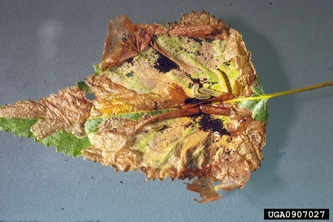Fenusa pusilla
One of the major pests of Birch trees in Connecticut is the birch leafminer. This pest derives its name from the larva's habit of feeding or mining the plant tissues between the upper and lower surfaces of birch leaves.

Damage
Leaves that are attacked soon turn brown. Affected trees, seen from a distance, have a scorched or blighted appearance that is often mistaken for a disease. Leaves examined at closer range have a blotched or blistered appearance. Under normal conditions, the tops of trees are often the most seriously affected portions. However, the entire tree can be affected. Normally a healthy tree can lose part or nearly all of the current crop of leaves without being seriously weakened; but repeated losses, year after year, will weaken the tree, resulting in death, or will make it susceptible to the attacks of other insects, especially the bronze birch borer, which will hasten the death of the tree. A well-watered tree can tolerate up to 60% leaf damage.
Host Trees
Trees most likely to be attacked are gray, paper and European white birch.
Life History
The birch leafminer is not a native insect but one accidentally introduced from Europe. The adults are small, black, four-winged sawflies about 1/8-inch long. The name "sawfly" is derived from the saw-like egg-laying organ of the female. These insects are related to wasps. The adults overwinter in the soil and begin to emerge in early to mid-May. They congregate about birches, mate, and females lay their eggs in newly developing terminal leaves until the peak period in late June. The eggs hatch in seven to 10 days, and the larvae begin feeding. At first, the mines are small and somewhat serpentine in form. As the larvae grow, feeding increases and the serpentine mines often run together to form the characteristic blotches and blisters. The larvae mature in one to two weeks, drop to the ground and enter the soil to pupate. New adults are small, 1/8-1/4" long, black and fly-like. They appear in about 15 to 20 days to start the cycle over again. During a normal year, a life cycle can be completed in five to six weeks. In Connecticut, each year there are three generations and sometimes a partial fourth generation. Only the first two generations are considered destructive, because adult females prefer to lay their eggs in soft, young tissue. Leaf surfaces are generally hardened when third and fourth generation adults appear. The final generation will drop to the ground, pupate, and remain there until the following spring.
Control
The birch leafminer may be controlled with sprays containing the recommended materials. Proper timing is essential for good control. Sprays should be applied just after the eggs hatch. Eggs of the first generation usually hatch around mid-May and those of the second generation in early July. These dates can be easily remembered as Mother's Day and the Fourth of July.
Begin examining terminal leaves in early May. When holding the leaves up to the light you can see small mines, it is time to spray. For best results, repeat the application seven to 10 days later. The second spray is needed because all the adults do not emerge at the same time. As a result, some larvae may appear after the effectiveness of the first spray is gone. Repeat the entire process in late June or early July for the second generation.
Despite good cultural practices, pests and diseases at times may appear. Chemical control should be used only after all other methods have failed. For pesticide information please call UConn Home and Garden Education Center or your local cooperative extension office.
The UConn Home & Garden Education Center supports UConn Extension’s mission by providing answers you can trust with research-based information and resources. For gardening questions, contact us toll-free at (877) 486-6271, visit our website at homegarden.cahnr.uconn.edu, or reach out to your local UConn Extension center at cahnr.uconn.edu/extension/locations.
Revised by the UConn Home & Garden Education Center, 2019.